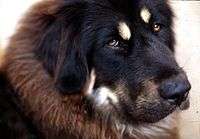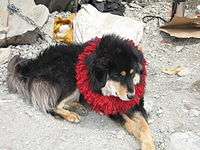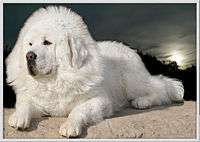Tibetan Mastiff
The Tibetan Mastiff (Tibetan: འདོགས་ཁྱི, Wylie: Dogs khyi; Chinese: 藏獒, Pinyin: Zàng áo) is a large Tibetan dog breed belonging to the mastiff family. Its double coat is long, subject to climate, and found in a wide variety of colors, including solid black, black and tan, various shades of red (from pale gold to deep red) and bluish-gray (dilute black), often with white markings.
| Tibetan Mastiff | |||||||||||
|---|---|---|---|---|---|---|---|---|---|---|---|
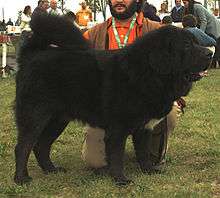 Mastiff | |||||||||||
| Origin | Tibet | ||||||||||
| |||||||||||
| |||||||||||
| Dog (domestic dog) | |||||||||||
Names and etymology
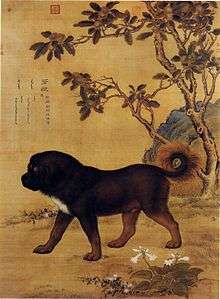
The Tibetan Mastiff known as 'Dogs-Khyi in Tibetan,[2] reflects its use as a guardian of herds, flocks, tents, villages, monasteries and palaces, much as the Old English Bandog (also meaning tied dog) was a dog tied outside the home as a guardian. However, in nomad camps and in villages, the 'Dogs-Khyi is traditionally allowed to run loose at night. This dog is known for its loyalty and has been used as a nomad dog for thousands of years.[3]
The guardian type from which the modern Tibetan Mastiff breed has been derived was known across the ancient world by many names. Bhote Kukur in Nepali as bhote means someone from Tibet and kukur means dog. The Chinese name for the breed is Zàng áo (Cantonese: Tzong ngou), meaning "Tibetan Mastiff-dog". In Mongolia, a similar-looking dog is called bankhar, but this dog is genetically distinct (a different Traditional Native Landrace Breed) and is of a more ancient lineage.
.jpg)
The name Tibetan Mastiff is a misnomer; the Tibetan Mastiff is not a true Mastiff. The term "mastiff" was assigned by the Europeans who first came to Tibet because it was used to refer to nearly all large dog breeds in the West. Early Western visitors to Tibet misnamed several of its breeds: The "Tibetan Terrier" is not a terrier and the "Tibetan Spaniel" is not a spaniel. A better name for the breed might be the Tibetan Mountain Dog or, to encompass the landrace breed throughout its range, the Himalayan mountain dog.[4]
Description
Appearance
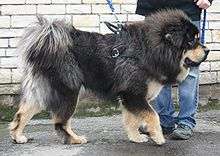
Some breeders differentiate between two "types" of Tibetan Mastiff, the Do-khyi (-gs is not pronounced in Lhasa Tibetan) and the Tsang-khyi. The Tsang-khyi (which, to a Tibetan, means only "dog from Tsang") is also referred to as the "monastery" type, described as generally taller, heavier, and more heavily boned, with more facial wrinkling and haw than the Do-khyi or "nomad" type. Both types are often produced in the same litter with the larger, heavier pups being placed in more stationary jobs versus more active jobs for the Tibetan Mastiffs that are better structured and well-muscled.
The Tibetan Mastiff is considered a primitive breed. It typically retains the hardiness which would be required for it to survive in Tibet and the high-altitude Himalayan range, including the northern part of Nepal, India[5] and Bhutan.
Instinctive behaviors including canine pack behavior contributed to the survival of the breed in harsh environments. It is one of the few primitive dog breeds that retains a single estrus per year instead of two, even at much lower altitudes and in much more temperate climates than its native climate. This characteristic is also found in wild canids such as the wolf and other wild animals. Since its estrus usually takes place during late fall, most Tibetan Mastiff puppies are born between December and January.[6]
Its double coat is long, subject to climate, and found in a wide variety of colors, including solid black, black and tan, various shades of red (from pale gold to deep red) and bluish-gray (dilute black), often with white markings. Some breeders are now (as of 2014) marketing white Tibetan Mastiffs. These dogs are actually very pale gold, not truly white. Photoshop is often used to make dogs of normal color(s) appear white in advertisements.
The coat of a Tibetan Mastiff lacks the unpleasant big-dog smell that affects many large breeds. The coat, whatever its length or color(s), should shed dirt and odors. Although the dogs shed somewhat throughout the year, there is generally one great molt in late winter or early spring and sometimes another, lesser molt in the late summer or early fall. (Sterilization of the dog may dramatically affect the coat as to texture, density and shedding pattern.)
Tibetan Mastiffs are shown under one standard in the West, but separated by the Indian breed standard into two varieties: Lion Head (smaller; exceptionally long hair from forehead to withers, creating a ruff or mane) and Tiger Head (larger; shorter hair).
Temperament
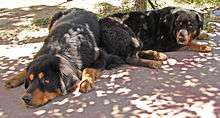
.jpg)
As a flock guardian dog in Tibet and in the West, it uses all the usual livestock guardian tactics (e.g., barking, scent-marking perimeters) to warn away predators and avoid direct confrontations.[4]
As a socialized, more domestic dog, it can thrive in a spacious, fenced yard with a canine companion, but it is generally not an appropriate dog for apartment living. The Western-bred dogs are generally more easy-going, although somewhat aloof with strangers coming to the home. Through hundreds of years of selective breeding for a protective flock and family guardian, the breed has been prized for being a nocturnal sentry, keeping would-be predators and intruders at bay, barking at sounds throughout the night. Leaving a Tibetan Mastiff outside all night with neighbors nearby is not recommended. They often sleep during the day, making them more active, alert and aware at night.[4]
Like all flock guardian breeds, they are intelligent and stubborn to a fault, so obedience training is recommended (although it is only mildly successful with some individuals) since this is a strong-willed, powerful-bodied breed. Unless they are to be used exclusively as livestock guardians, socialization training is also critical with this breed, because of their reserved nature with strangers and guardian instincts. They can be excellent family dogs – depending on the family. Owners must understand canine psychology and be able and willing to assume the primary leadership position. Lack of consistent, rational discipline can result in the creation of dangerous, unpredictable dogs. The protectiveness of Tibetan Mastiffs requires alertness and planning by the owner, in order to avoid mishaps when the dog is simply acting as a guardian. The breed is not recommended for novice dog owners.[4][5]
Health
.jpg)
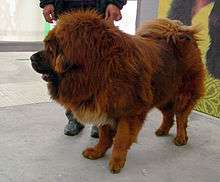
Many breeders claim a life expectancy of 10–16 years, but these claims are unsubstantiated. Some lines do produce long-lived dogs. Other, more closely inbred lines, produce short-lived, unhealthy dogs. The breed has fewer genetic health problems than many breeds, but cases can be found of hypothyroidism, entropion, ectropion, distichiasis, skin problems including allergies, autoimmune problems including demodex, Addison's disease, Cushing's disease, missing teeth, malocclusion (overbite, underbite, dry mouth), cardiac problems, seizures, epilepsy, progressive retinal atrophy (PRA), cataracts, and small ear canals with a tendency for infection. As with most large breeds, some will suffer with elbow or hip dysplasia.
Canine inherited demyelinative neuropathy (CIDN), an inherited condition, appeared in one of the prominent lines of Tibetan Mastiffs in the early 1980s.[7] Unfortunately, known carriers were bred extensively and are behind many lines still being actively bred. Because the mode of inheritance appears to be as a simple recessive, continued inbreeding can still produce affected puppies.
Hypothyroidism is fairly common in Tibetan Mastiffs, as it is in many large "northern" breeds. They should be tested periodically throughout their lives using a complete thyroid "panel". However, because the standard thyroid levels were established using domestic dog breeds, test results must be considered in the context of what is "normal" for the breed, not what is normal across all breeds. Many dogs of this breed will have "low" thyroid values, but no clinical symptoms. Vets and owners differ on the relative merits of medicating dogs which test "low", but are completely asymptomatic. Some researchers think that asymptomatic hypothyroidism may have been adaptive in the regions of origin for many breeds, since less nutrition is required for the dog to stay in good condition. Therefore, attempts to eliminate "low thyroid" dogs from the Tibetan Mastiff gene pool may have unintended consequences for the breed.
History
The Tibetan mastiff originated as a herding and guarding dog for the nomads of Tibet, and as a watchdog in Tibetan monasteries.[8][4][5]
The Tibetan mastiff is a phenotypically distinct dog breed that was bred as a flock guardian in the high altitudes of the Himalayas and the Tibetan Plateau.[9][10]
In 1872, one writer stated:
The dogs of Thibet are twice the size of those seen in India, with large heads and hairy bodies. They are powerful animals, and are said to be able to kill a tiger. During the day they are kept chained up, and are let loose at night to guard their masters' house.[11]
In the early 20th century, King George V introduced a pair of Tibetan Mastiffs, and enough of the breed were available in England in 1906 to be shown at the Crystal Palace show. However, during the war years, the breed lost favor and focus and nearly died out in England.
After 1980, the breed began to gain in popularity worldwide. Although the breed is still considered somewhat uncommon, as more active breeders arose and produced adequate numbers of dogs, various registries and show organizations (FCI, AKC) began to recognize the breed.
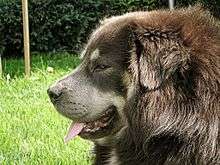
Since AKC recognition, the number of active breeders has skyrocketed, leading to over-production of puppies, many of which are highly inbred and of questionable quality. Initially, the breed suffered because of the limited gene pool from the original stock, but today's reputable breeders work hard at reducing the genetic problems through selective breeding and the international exchange of new bloodlines. However, some few breeders cling to the practice of inbreeding, do not perform health tests on their breeding stock, and do not support buyers of the puppies they produce. Many puppies and adult dogs end up in shelters and in rescue situations.
In 2008, the Tibetan Mastiff competed for the first time in the Westminster Kennel Club Dog Show.
A Chinese woman was reported[12] to have spent more than 4 million yuan to buy an 18-month-old purebred male Tibetan Mastiff, which she named Yangtze No. 2.[13] In March 2011, a red Tibetan Mastiff was reported to have been sold to a 'coal baron' from northern China for 10 million yuan.[13] There have been other similar reports of dogs sold for astronomical prices; however, most of these appear to be breeders' attempts to drive up the prices of their dogs.[14] Photos of dogs shown on web sites are frequently photoshopped to exaggerate color intensity, size, and "bone". By 2015, due to copious production by breeders and unsuitability of the breed as a pet in urban situations, prices in China for the best dogs had fallen to about $2,000 and both lower quality and crossbreed dogs were being abandoned.[15]
In 2013, a zoo in Louhe, China attempted to pass off a Tibetan Mastiff as an African lion.[16]
In 2011, a DNA study concluded that there was a genetic relationship between the Tibetan Mastiff and the Great Pyrenees, Bernese Mountain Dog, Rottweiler and Saint Bernard, and that these large breed dogs are probably partially descended from the Tibetan Mastiff.[17] In 2014, a study added the Leonberger to the list of possible relatives.
Admixture with the Tibetan wolf
The Tibetan Mastiff was able to adapt to the extreme highland conditions of the Tibetan Plateau very quickly compared to other mammals such as the yak, Tibetan antelope, snow leopard, and the wild boar. The Tibetan Mastiff's ability to avoid hypoxia in high altitudes, due to its higher hemoglobin levels compared to low-altitude dogs, was due to prehistoric interbreeding with the Tibetan wolf.[18][19]
Gallery
Popular culture
- A Tibetan Mastiff named “Max” is the central antagonist in the 1993 horror film Man's Best Friend. At least five different dogs were used in filming.
- A Tibetan Mastiff is the subject of the 2011 animated film The Tibetan Dog.
- A Tibetan Mastiff by the name of Mouse is the canine companion of the titular character of the Dresden Files book series.
- The animated film Rock Dog featured two Tibetan Mastiffs named “Bodi” and “Khampa” (voiced by Luke Wilson and J. K. Simmons, respectively).
- In the 2018 animated television series, Craig of the Creek, the character Wildernessa rides a Tibetan Mastiff, Cheesesticks.
- In the 2011 film Old Dog by director Pema Tseden, the Tibetan Mastiff of a herder family is coveted by several characters to be traded to rich Han Chinese in the eastern part of the country.
See also
- Dog of Osu
- Lhasa Apso
- Tibetan Kyi Apso
- Tibetan Spaniel
- Tibetan Terrier
References
- FCI breed standard
- Melvyn C. GoldStein; T.N. Shelling; J.T. Surkhang (eds.). The new Tibetan-English dictionary of modern Tibetan. p. 576. ISBN 0-520-20437-9.
- "Tibetan Mastiffs: The Tibetans' Best Friends". Tibet Travel and Tours - Tibet Vista. Retrieved 2019-01-23.
- Messerchmidt, Don (2010). Discovering the Big Dogs of Tibet and the Himalayas: A Personal Journey.
- Tibetan Dogs – A Complete Anthology of the Breeds. Vintage Dog Books. November 18, 2010. ISBN 1-4455-2671-9.
- "Tibetan Mastiff Dog Breed Information". American Kennel Club. Retrieved 9 March 2019.
- "The Tibetan Mastiff" by Ann Rohrer and Cathy J. Flamholtz
- Palika, Liz (2007). The Howell Book of Dogs: The Definitive Reference to 300 Breeds and Varieties. John Wiley & Sons. p. 374. ISBN 978-0-470-17585-9.
- Messerschmidt DMR. 1983. The Tibetan Mastiff: canine sentinels of the range. Rangelands 5:172–174.
- Li Q, Liu Z, Li Y, Zhao X, Dong L, Pan Z, Sun Y, Li N, Xu Y, Xie Z. 2008. Origin and phylogenetic analysis of Tibetan Mastiff based on the mitochondrial DNA sequence. J Genet Genomics. 35:335–340.
- Travels in Central Asia by Meer Izzut-oollah in the Years 1812–13. Translated by Captain Henderson. Calcutta, 1872, p. 15.
- "Rich Chinese Woman Pays More than US$500,000 for Rare Tibetan Mastiff Dog".
- Bates, Daniel (March 17, 2011). "The million-pound mutt: Red Tibetan Mastiff becomes world's most expensive dog". Daily Mail. London.
- "Dog 'sold for $2 million' in China".
- "Once-Prized Tibetan Mastiffs Are Discarded as Fad Ends in China". New York Times. New York Times Company. Retrieved 27 February 2017.
- Staff, By CNN. "Chinese zoo angers visitors by passing off Tibetan mastiff dog as lion". CNN. Retrieved 9 March 2019.
- Li, Y.; Zhao, X.; Pan, Z.; Xie, Z.; Liu, H.; Xu, Y.; Li, Q. (2011). "The origin of the Tibetan Mastiff and species identification of Canis based on mitochondrial cytochrome c oxidase subunit I (COI) gene and COI barcoding". Animal. 5 (12): 1868. doi:10.1017/S1751731111001042. PMID 22440462.
- Miao, Benpeng; Wang, Zhen; Li, Yixue (2016). "Genomic Analysis Reveals Hypoxia Adaptation in the Tibetan Mastiff by Introgression of the Grey Wolf from the Tibetan Plateau" (PDF). Molecular Biology and Evolution. 34: msw274. doi:10.1093/molbev/msw274. PMID 27927792.
- Signore, Anthony V.; Yang, Ying-Zhong; Yang, Quan-Yu; Qin, Ga; Moriyama, Hideaki; Ge, Ri-Li; Storz, Jay F. (2019). "Adaptive Changes in Hemoglobin Function in High-Altitude Tibetan Canids Were Derived via Gene Conversion and Introgression". Molecular Biology and Evolution. 36: 2227–2237. doi:10.1093/molbev/msz097. PMC 6759075. PMID 31362306.
- Alderton, David (1984). The Dog. London: Macdonald. ISBN 0-356-10443-5.
- Fogle, Bruce, DVM (2000). The New Encyclopedia of the Dog. Doring Kindersley (DK). ISBN 0-7894-6130-7.
- "Tibetan Mastiff, 'Big Splash,' Becomes World's Most Expensive Dog". The Huffington Post. May 25, 2011. Retrieved December 6, 2012.
- Kuang Ni [倪匡] (2000). 真实的藏獒 (The Real Tibetan Mastiff). Beijing: Guo ji wen hua chu ban gong si. ISBN 7-80173-535-8. OCLC 229909428.
- Messerschmidt, Don (2010). Big Dogs of Tibet and the Himalayas. Orchid Press ISBN 978-974-524-130-5.
- Palmer, Joan (1994). The Illustrated Encyclopedia of Dog Breeds. ISBN 0-7858-0030-1.
- Schuler, Elizabeth Meriwether (ed.) (1980). Simon & Schuster's Guide to Dogs. ISBN 0-671-25527-4.
- "World's most expensive dog costs a million pounds". Sify News. IANS. March 16, 2011. Retrieved December 6, 2012.
External links
| Wikimedia Commons has media related to Tibetan Mastiff. |
| Wikinews has related news: |
- Tibetan Mastiff at Curlie
- Tibetan Mastiff Craze Sweeps China—slideshow by The Huffington Post
Dan Rafael kupal
